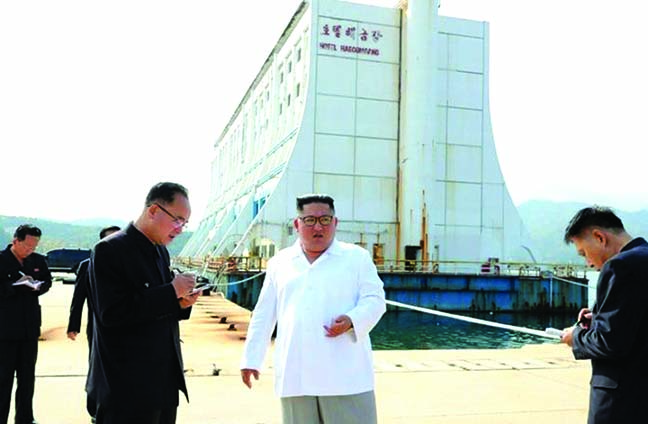
AFP, Seoul :
The tourism industry, which is not included in the international sanctions imposed on North Korea over its missile and nuclear development program, has become the focal point of the government as a main source for the nation’s economic growth.
Kim has pointed to promoting tourism as a key component of his policy of “self-reliant” economic growth.
“The entire people should cherish the belief that self-reliance is the only way to live. There is nothing more foolish than to expect help from others today,” an editorial in the state-run newspaper Rodong Sinmun said on Wednesday.
The renewed insistence on self-reliance came as the United Nations warned on Tuesday that food insecurity in North Korea had reached alarmingly high levels, with nearly 11 million people being undernourished.
Tomas Ojea Quintana, United Nations independent investigator on human rights in North Korea, also said that an estimated 140,000 children in North Korea were suffering from “under-nutrition”, including 30,000 who “face an increased risk of death.”
South’s President Moon has on more than one occasion talked about the possibility of resuming Mt. Kumgang tours in recent years.
Following a summit with Kim in Pyongyang in September 2018, Moon said that the two sides had agreed to work towards setting up Mt. Kumgang tours and the Kaesong industrial complex.
In April, United States President Donald Trump was asked to give his view about the possibility of restarting tours to Mt. Kumgang.
“This isn’t the right time, but at the right time I’d have great support,” Trump said, according to South Korean presidential office records.
But tours came to an abrupt end in 2008 after a North Korean soldier shot dead a Southern tourist who strayed off the approved path and Seoul suspended travel.
Pyongyang had long wanted to resume the lucrative visits, but the tours would now violate international sanctions imposed on North Korea over its nuclear and ballistic programmes.
Kim visited the site and lambasted the “shabby” buildings as “just a hotchpotch with no national character at all”, the North’s official KCNA news agency reported, adding “they were built like makeshift tents in a disaster-stricken area or isolation wards” and “very backward in terms of architecture”.
“He instructed to remove all the unpleasant-looking facilities of the south side,” KCNA said, “and to build new modern service facilities our own way”.
The announcement is a striking repudiation of what was once one of the two biggest inter-Korean projects, along with the now-shuttered Kaesong Industrial Complex, where Southern companies employed North Korean workers while paying Pyongyang for their services.
It came only a day after the South’s President Moon Jae-in – who has long championed engagement with the North – touted the benefits of a possible “peace economy” in a speech to Seoul’s parliament.
But contact between the neighbours stalled after the collapse of a February summit between Kim and US President Donald Trump in Hanoi, and Pyongyang has since repeatedly excoriated Seoul, saying it has “nothing to talk any more” with it.
While Kim said the demolition should proceed “with an agreement with the relevant unit of the south side”, he added the view that Mount Kumgang was “a common property of the north and the south” was “a mistaken idea and a misguided understanding”.
“Mt Kumgang is our land won at the cost of blood and even a cliff and a tree on it are associated with our sovereignty and dignity,” it cited him as saying.
“We will always welcome our compatriots from the south if they want to come to Mt Kumgang,” he said, but it was “not desirable to let the south side undertake the tour of Mt Kumgang, our famous mountain”.
Hyundai Asan spent 220 billion won (now $190 million) on building the site, with another 559 billion won paid in fees to the North’s authorities, the company says.
A company representative told AFP they were “taken aback with the news as we have been preparing for the resumption of tours”, but added they would “deal with it calmly”.
lThe tourism industry, which is not included in the international sanctions imposed on North Korea over its missile and nuclear development program, has become the focal point of the government as a main source for the nation’s economic growth.
Kim has pointed to promoting tourism as a key component of his policy of “self-reliant” economic growth.
“The entire people should cherish the belief that self-reliance is the only way to live. There is nothing more foolish than to expect help from others today,” an editorial in the state-run newspaper Rodong Sinmun said on Wednesday.
The renewed insistence on self-reliance came as the United Nations warned on Tuesday that food insecurity in North Korea had reached alarmingly high levels, with nearly 11 million people being undernourished.
Tomas Ojea Quintana, United Nations independent investigator on human rights in North Korea, also said that an estimated 140,000 children in North Korea were suffering from “under-nutrition”, including 30,000 who “face an increased risk of death.”
South’s President Moon has on more than one occasion talked about the possibility of resuming Mt. Kumgang tours in recent years.
Following a summit with Kim in Pyongyang in September 2018, Moon said that the two sides had agreed to work towards setting up Mt. Kumgang tours and the Kaesong industrial complex.
In April, United States President Donald Trump was asked to give his view about the possibility of restarting tours to Mt. Kumgang.
“This isn’t the right time, but at the right time I’d have great support,” Trump said, according to South Korean presidential office records.

